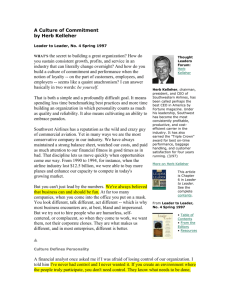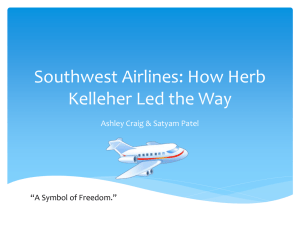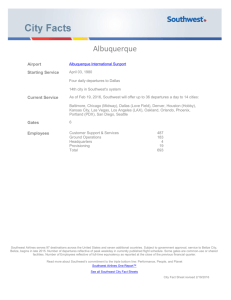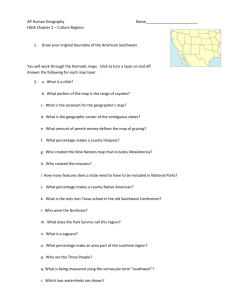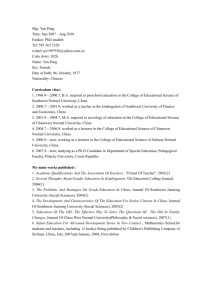Module #6 - Integrity Works
advertisement
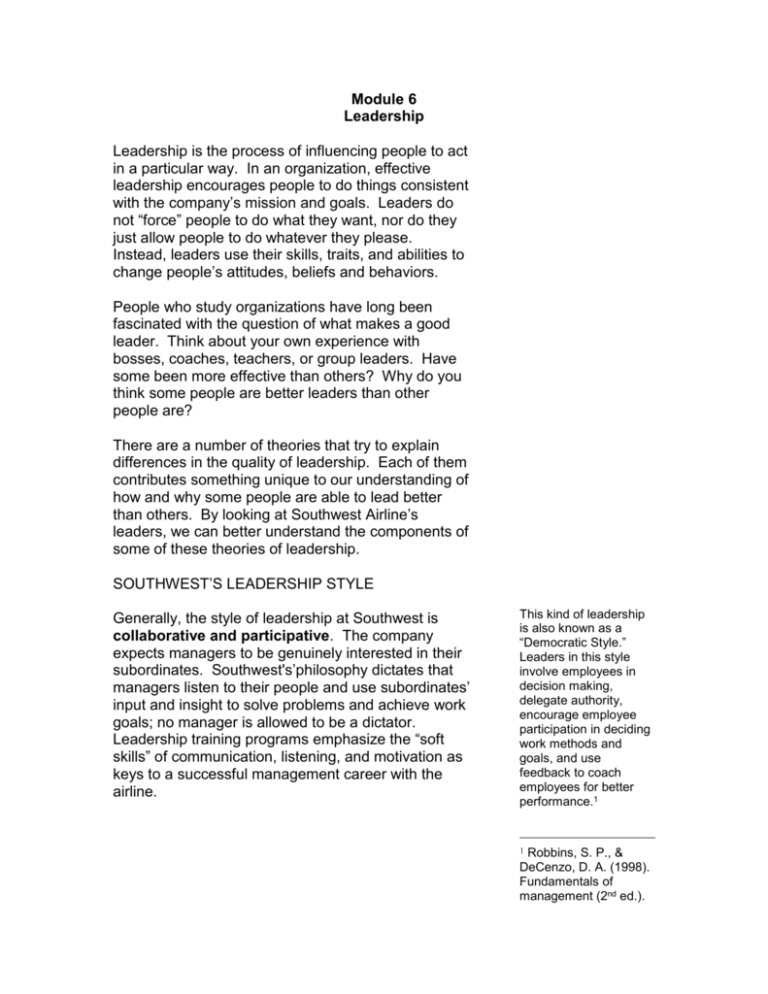
Module 6 Leadership Leadership is the process of influencing people to act in a particular way. In an organization, effective leadership encourages people to do things consistent with the company’s mission and goals. Leaders do not “force” people to do what they want, nor do they just allow people to do whatever they please. Instead, leaders use their skills, traits, and abilities to change people’s attitudes, beliefs and behaviors. People who study organizations have long been fascinated with the question of what makes a good leader. Think about your own experience with bosses, coaches, teachers, or group leaders. Have some been more effective than others? Why do you think some people are better leaders than other people are? There are a number of theories that try to explain differences in the quality of leadership. Each of them contributes something unique to our understanding of how and why some people are able to lead better than others. By looking at Southwest Airline’s leaders, we can better understand the components of some of these theories of leadership. SOUTHWEST’S LEADERSHIP STYLE Generally, the style of leadership at Southwest is collaborative and participative. The company expects managers to be genuinely interested in their subordinates. Southwest's’philosophy dictates that managers listen to their people and use subordinates’ input and insight to solve problems and achieve work goals; no manager is allowed to be a dictator. Leadership training programs emphasize the “soft skills” of communication, listening, and motivation as keys to a successful management career with the airline. This kind of leadership is also known as a “Democratic Style.” Leaders in this style involve employees in decision making, delegate authority, encourage employee participation in deciding work methods and goals, and use feedback to coach employees for better performance.1 1 Robbins, S. P., & DeCenzo, D. A. (1998). Fundamentals of management (2nd ed.). To be successful, Southwest’s’ leaders rely heavily on the fact that workers share both their goals for the company and their work values. As we’ve already noted, Southwest is careful to hire people that can develop a real concern for their internal and external customers. Leaders at Southwest take advantage of this. Because they know employees will act for the good of the company, they can delegate a great deal of decision-making authority. Leaders at Southwest are taught to express belief in their subordinate’s talents and capabilities. As you might expect, they are also consistently reminded not to take themselves too seriously. SIDEBAR: Bob Rapp, VP of Systems at Southwest, is described by his subordinates as a “visionary.” Ken Rundas, Director of Solutions and Systems, said, “He’ll leave every opportunity, even though it sometimes may be more difficult in the short term, for people to develop through a situation by doing it on their own with him coaching from the sideline.”3 LEADERSHIP TRAINING AT SOUTHWEST Southwest holds leadership classes for management-level employees about every two years. Here, employees learn the difference between merely being a manager who directs the work of others and being a leader who encourages and promotes others. CEO Herb Kelleher describes the message of these seminars as follows: “We tell these employees to stop managing; when they manage themselves, they are ready to start leading. We tell them to stop administering because we want them to be leaders. And that’s what we’re looking for because leaders are so scarce. The focus is entirely upon how to get different people with different backgrounds to work together harmoniously for a goal. What makes companies ultimately perform well is when everybody is leading and there’s a little less management and administration – bureaucracy, in other words.”2 Leadership Classes: Most of Southwest’s internal training is conducted at their “University for People” located at Dallas’ Love Field. Trainees can walk directly from the Southwest Airline gate to their classroom, then fly home again that evening. (PHOTO OF CORP HQ @ http://www.iflyswa.com/i nfo/photos.html) CHOOSING TO LEAD Southwest recognizes that many people can advance to managerial positions where they direct the work of other people. However, only a few people have the necessary talents and skills to really lead others. Consequently, the company is constantly on the lookout for people that demonstrate 3 Upper Saddle River, NJ: Prentice Hall. 2 Kelleher, H. (1998, May/June). Customer Service: It Starts at Home. The Secured Lender, v54#3, pp. 68-73. Malloy, A. (1996, June). On the job: Southwest Airlines. Computerworld, p. 47+. that they have what it takes to lead. But what identifies a potential leader? WHAT MAKES A GOOD LEADER? Many researchers believe that some people’s personal characteristics make them better leaders than others. This belief is known as the “Great Person Theory.” People who subscribe to this theory believe that leaders possess special traits that set them apart from other people. The theory was most popular early in the twentieth century, and prompted a significant amount of research. We now know that successful leaders are, as you would expect, intelligent people with drive. They have energy, are ambitious, and show initiative.4 SIDEBAR: Respected leaders usually have a long history of hard work and success. Southwest’s CEO Kelleher was a successful athlete and study body president at Haddon Heights High School and Wesleyan University in Connecticut. He also made Law Review at New York University Law School.5 Another personal characteristics more prominent among recognized leaders than other people is “leadership motivation,” or the desire to take a leadership role. This is straightforward: people who want to be in leadership positions tend to do a better job than those who do not. Recognizing this, Southwest invites people to attend their leadership training program, but does not assign or “force” anyone into a supervisory or management role. Also, Southwest’s pay structure favors seniority, rather than position in the organization. Consequently, people do not feel that they have to take a promotion simply to get ahead financially. This policy insures that people who are leaders at Southwest WANT to be leaders...an important element of their success. Self-confidence is another important trait that most successful leaders possess in abundance. Their ability to believe in themselves and their ideas helps followers to believe in them as well. Some leaders possess a special kind of self-confidence that inspires subordinates to see them as hero-like figures. We call these individuals charismatic leaders. Herb Kelleher, Southwest’s CEO, is perhaps the most widely acknowledged charismatic leader in American business. 4 Kirkpatrick, S. A., & Locke, E. A. (1991). Leadership: Do traits matter? Academy of Management Executive, v5, pp. 48-60. 5 Labich, K. (1994, May 2). Is Herb Kelleher America’s best CEO? Fortune, v129#9, p. 44+. HERB KELLEHER: A SPECIAL LEADER The theory of charismatic leadership is based on the premise that followers often attribute heroic or extraordinary abilities to particular individuals.6 Herb Kelleher’s employees see him as a hero, and his ability to inspire their devotion is nothing short of amazing. To celebrate a recent “bosses day,” Southwest employees donated $60,000 to buy a fullpage ad in USA Today to thank and commemorate Kelleher.7 At the many gatherings, both planned and impromptu, that take place on Southwest’s corporate headquarter’s patio, Kelleher can always be found surrounded by a group of admiring people who find joy in simply listening to him speak. KELLEHER IS A CHARISMATIC LEADER Charismatic leaders are known to inspire their employees to do great things. Significant research tells us that charismatic leaders tend to have high performing, well-satisfied subordinates.8 People also tend to like charismatic leaders personally, and so are motivated to put forth extra effort for them.9 These effects have certainly been seen at Southwest Airlines. Kelleher’s leadership is one of the most important components of Southwest’s success. Researchers have identified a number of behavioral characteristics that help us identify a charismatic leader. We’ll examine some of these to explain why 6 Conger, J. A., & Kanungo, R. N. (1988). Charismatic Leadership. San Francisco: Jossey-Bass. 7 Rigler, G. C. (1995, March). Case study: Southwest airlines. Across the Board, v32#3, p. 56+. 8Agle, B. R., & Sonnenfeld, J. A. (1994, August 14-17). Charismatic chief executive officers: Are they more effective? An empirical test of charismatic leadership theory. In D. P. Moore (Ed.), Academy of Management Best Papers Proceedings 1994, pp. 2-6. 9 House, R. J. (1977). A 1976 theory of charismatic leadership. In J. G. Hunt & L. L. Larson (Eds.), Leadership: The cutting edge (pp. 189-207). Carbondale, IL: Southern Illinois University Press. SIDEBAR: Southwest’s Chief Operating Officer, Jim Wimberly has a lifesized cardboard cutout of Herb Kelleher in his office...sort of. Actually, Kelleher’s head has been transposed onto a promotional figure for Wild Turkey, Kelleher’s favorite bourbon. Herb Kelleher is widely identified as charismatic.10 1. Vision. Charismatic leaders have a compelling goal. In some way, they want to make the future better, and they are fully committed to achieving what they see as possible. Kelleher’s vision is simple: he wants to make air travel accessible to everyone. As we noted in Module 2, his idea of a “short hop” airline revolutionized the industry. 2. Ability to articulate the vision. Not only do charismatic leaders have a vision of how the future might be better, they also come up with ways to communicate that vision to others. They allow people to understand their dreams, and others come to first understand and then share their vision. Charismatic leaders aren’t afraid to talk about their ideas. They they communicate them effectively...and often. When you log onto the Southwest Airlines web page, you are invited to click on a picture of Kelleher to learn more about him. Rather than personal information about himself, Kelleher’s web page is a statement of his vision for Southwest Airlines. Employees take his message about customer service to heart: it is not unusual for a Southwest worker to rationalize going out of their way to help a customer because “It’s what Herb would do.” 3. Self-confidence. Charismatic leaders trust their abilities. The have confidence in their judgment and decisions, and this helps followers believe in them as well. Kelleher’s self-confidence is so high that he often pokes fun at himself for it. For example, when asked if he ever planned on retiring, Kelleher replied “No, because I’m immortal.”11 Through the humor, Southwest employees got the message. There is no doubt that Herb believes in himself. 10 The list of behaviors is taken from Conger, J. A., & Kanungo, R. N. (1988). Charismatic Leadership. San Francisco: JosseyBass. 11 “How Herb keeps Southwest hopping” (1999, April). Money, v28#6, pp. 61-62+. SIDEBAR: Kelleher not only tell his employees about his vision for excellent customer service...he shows them. Like all top managers at Southwest, Herb regularly spends a day performing the job of a typical Southwest employee such as a baggage handler, reservation agent, or flight attendant. PHOTO OF HERB PASSING OUT PEANUTS AS FLIGHT ATTENDANT AVAILABLE ONLINE: http://www.iflyswa.com/i nfo/photos.html; title “Our Chairman, President, CEO & Flight Attendant.” 4. Unusual, extraordinary behavior. Charismatic leaders behave in unusual ways. They do things that are unexpected, abnormal, and quirky. These behaviors not only get employees’ attention, but they make the leader...and their vision...more memorable. Herb Kelleher personifies the silly, often goofy antics that are commonplace at Southwest Airlines. He appears in costume for company events, rewards employees for telling good jokes, and makes up songs while presenting service awards. Impromptu celebrations are commonplace at Southwest. Kelleher defends the cost, in both money and time, of this practice by noting that “What we do communicates itself to the outside world in better service and warmer hospitality.”12 He believes that the parties and get-togethers keep his employees happy, and when employees are happy, they treat customers well. SIDEBAR: Kelleher’s antics are so strongly associated with Southwest’s corporate image that they are even used in recruiting advertisements. One ad pictured him dressed as Elvis, with the slogan, “Work in a place where Elvis has been spotted.” The ad ends by saying, “If you see him dressed as Ethel Merman, ignore him; we’re trying to cure him of that.” TO SEE THIS AND OTHER SOUTHWEST ADS: Web address is http://www.iflyswa.com/ promotions/netads.html THE DOWNSIDE OF CHARISMA However, despite the positive outcomes associated with charismatic leaders, there can be a downside for companies with such a visible and well-known CEO as Kelleher. One of the biggest dangers of charismatic leadership is embedded in a central characteristic of charismatic leaders: their selfconfidence. Sometimes people who are highly selfconfident have difficulty listening to others’ ideas, which makes them less effective managers in the long run. At Southwest, any tendencies Kelleher might have in this area are well overcome by the open and participative management style he has developed. In fact, any employee can write to Kelleher with an idea, problem, or suggestion at any time...and all letters are personally answered. Additionally, people with the ability to persuasively communicate a vision and inspire others to share that vision have great power...and the temptation to use that power in negative ways might be compelling. 12 Gruner, S. (1998, May). Have fun, make money. Inc., v20#6, p. 123+. SIDEBAR: Luckily, by all accounts Kelleher’s charisma is based on a positive and honest mentality. As one employee put it: “Anyone who has ever met Herb Kelleher will tell you that whether he’s talking to a U.S. Supreme Court justice, a member of his board of directors, or a hotel valet, he displays the same level of genuine interest and intensity. Herb doesn’t have a patronizing bone in his body, and this is the way he runs the airline.”13 13 Freiberg, J. & Freiberg, K. (1996, (Historians generally agree that Adolf Hitler was a charismatic leader.) KELLEHER AS TRANSFORMATIONAL LEADER Some charismatic leaders are able to avoid these downfalls, and Kelleher appears to be one. These leaders have charisma, but also something more: the ability to transform and empower the people working for them. We call these individuals transformational leaders, and Kelleher possess some of the special qualities of a transformational leader. 1. Intellectual Stimulation. First, transformational leaders care first and foremost about their people. They provide them with intellectual stimulation, motivating them to recognize and solve problems on their own. As we noted in Module 5, Southwest employees are fully empowered to solve almost every problem they encounter. Kelleher’s formal policy is, “No employee will ever be punished for using good judgment and good old common sense when trying to accommodate a customer – no matter what our rules are.”14 2. Individualized Consideration. Transformational leaders make their employees feel as if they are important as individual people, not just nameless workers. In this arena, Kelleher is a master. His ability to remember the names of, and personal details about, literally thousands of Southwest’s’ employees is legendary. He never hesitates to credit his staff for the success of both himself and the airline. Under his leadership, employees are encouraged to display personal photographs in the office and share their lives with co-workers. Transformational leaders enjoy similar successes to charismatic leaders. However, because they empower their employees and self-based action, their impression on a company is more lasting September). Is this company completely nuts? Executive Excellence, v13#9, p. 20+. 14 Rosenspan, A. (1998, December). Airline soars to new heights. Direct Marketing, v61#8, pp. 18-21. SIDEBAR: What asked how he has stayed motivated for 25 years, Kelleher says “The people. They have the hearts of lions, the strength of elephants and the determination of water buffaloes...We receive thousands of letters a year from customers commending employees for driving two hours to drop off luggage, or for buying lunch for someone who was stranded at the airport.”15 15 McGoon, C. (1999, April/May). Aim low, lefty, they’re riding shetlands! and positive. If a leader is only charismatic, the focus is on the leader. With transformational leaders, the focus is where it belongs: on the employees and the company they form. There is little doubt that Herb Kelleher is truly a people-focused transformational leader. SO...CAN HERB DO ANYTHING WRONG? Despite the advantages that Kelleher brings to Southwest, there are potential difficulties that should be acknowledged. Like any high-visibility CEO, Kelleher may draw attention to himself at the expense of his airline. In the short run, his antics provide Southwest with a great deal of free publicity. In fact, when Herb arm-wrestled the head of another airline for the right to use the advertising slogan “Just Plane Smart,” the event was so well publicized that Kelleher and his opponent received personalized letters from then President George Bush. These events make people familiar with Kelleher and his company. But in the long run, the public needs to be more familiar with the name “Southwest” than “Kelleher” when they look for an airline. (Kelleher lost the contest, by the way.) Companies with a highly visible charismatic leader also face a difficult question: what will they do when the leader leaves? Despite his claim to immortality, Kelleher is thought to be planning retirement within 57 years, and his health is rumored to be failing. His departure will be a challenge for Southwest. As Chief Financial Officer Gary Kelly reflected, “After he retired, you can see someone wanting to try something different and the cry going up, ‘Herb would never do it that way!’ That will be interesting. We’re certainly very powerful as a company, but we’re not invincible.”16 It will be interesting to see how Southwest replaces their leader. Kelleher is an important part of Southwest’s culture, and some observers note that the company may actually have difficulty surviving after he leaves. Communication World, v16#5, pp. 30-32. 16 Fisher, L. (1998, July). Success in a nutshell. Accountancy, v122#1259, pp. 28-29+ SIDEBAR: Interestingly, Kelleher has long been unwilling to name a successor to his CEO spot. Though he has been repeatedly asked to do so, Herb will not name anyone, either inside or outside Southwest, that he believes should take over his job when he retires.
